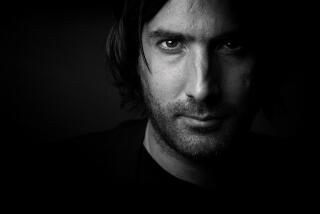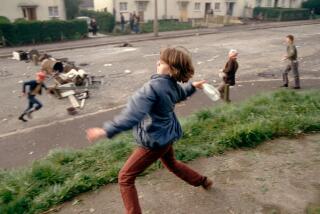The Grim Riddle of Britain’s Last Colony : LIVING WITH WAR A Belfast Year<i> by Sally Belfrage (Elizabeth Sifton Books/Viking: $19.95; 303 pp.)</i> : BELFAST DIARY War as a Way of Life<i> by John Conroy (Beacon Press: $18.95; 218 pp.) </i>
- Share via
I am what the Northern Irish call a Brit. My ancestors made Ireland Britain’s first colony. When the southern 26 counties won independence in 1921, the remaining six northern counties became part of the United Kingdom. My passport informs me that I am still a member of this fictive community. In fact, it reminds me that Northern Ireland remains Britain’s last colony. Not that I needed reminding. Until I left London to come to live in Los Angeles last summer, the Troubles (as everyone refers to the sectarian war in the North) were my regular diet on television and in the press. The Ulster marching season with its accompanying riots was as regular a feature of my year as Christmas. I felt as if I knew Belfast almost as well as London. Both these books make me realize that I didn’t.
Sally Belfrage and John Conroy both spent time living in Belfast. Conroy is a journalist from Chicago who won a grant to take a year off in Belfast. Belfrage is a Californian who lives in London and who spent a year visiting Belfast for a week or more each month. Both their accounts of what is going on there give a completely different picture from that which I and most mainlanders obtained from the press. I knew about the rioting, for instance, but I did not realize that the biggest policing problem is not the IRA or terrorism but juvenile crime. I knew that more than half the Catholic population was unemployed. But I didn’t know that only 21% of them favored a united Ireland. I knew that two out of three mainlanders wanted no further involvement with Northern Ireland (I was one of them). But I had no idea that the majority of Southern Irish thought that Northern Catholics had more in common with Northern Protestants than with themselves and were not prepared to pay more taxes for a united Ireland.
Far more than such statistics, what both books principally have to offer is a feel for the life that most ordinary Belfasters have been experiencing since the Troubles began in 1969. Conroy spent his year there in 1980, and he revisited the city most subsequent years. His account is close to that of a diary, with a succinct survey of Ireland’s earlier history. Because he stayed exclusively in a Catholic boarding house, he shows more sympathy for the Catholics he got to know than for the Unionists or the British security forces. But he distinguishes between ordinary Catholics and Republican paramilitarists who terrify him and his Catholic landlady alike.
Belfrage has less historical sense. She obtained most of her data over a single year. But she compensates by relying on the taped conversations she had with her hosts on both sides of the sectarian divide. She organizes these vivid monologues under such headings as “peace” (a dirty word in Ulster), “The Glorious Twelfth” (when the Protestants celebrate William’s victory over James’ Catholic forces in 1690, oblivious of the fact that William was helped by the Pope), “Crack” (Belfast talk, lyrical, inventive and funny), and the like. Most of the voices tell of tremendous hardship with surprising little bitterness. In one chapter dealing with the injustices of the courts, a woman talks about how she treated three unemployed men to soup only to find that she had 40 pence instead of the 80 it cost. For failing to pay the full cost, she was arrested and sentenced to a month’s imprisonment. This is happening today in the supposed cradle of democracy.
Neither writer can see any easy solutions to the situation. Most of the Northern Irish appear to prefer the tribal (not religious) war that has become their way of life to any alternative. The Irish Republic seems unwilling to adapt its constitution to separate church from state and make it possible for Protestants to want to become a part of it. The British pour billions of pounds and thousands of soldiers into the province, but fail to take the most elementary practical measures such as integrating the state Protestant schools with the state-subsidized Catholic schools.
Which book would I recommend most? Both. Conroy, by placing the present Troubles in their historical contest, is the best introduction. But the variety of Belfast voices that speak out to one in Belfrage’s book give one the best flavor of what it really feels like there.
More to Read
Sign up for our Book Club newsletter
Get the latest news, events and more from the Los Angeles Times Book Club, and help us get L.A. reading and talking.
You may occasionally receive promotional content from the Los Angeles Times.







